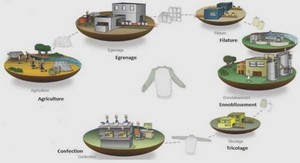Étude histo-pathologique et moléculaire de la résistance des vanilliers
Botany of Vanilla
Vanilla is a herbaceous, perennial and tropical climbing semi-epiphytic orchid. The basic chromosome number of vanilla genus is x= 16, with V. planifolia a diploid species with 2n= 32, together with V. pompona Schiede. and V. tahitensis J.W Moore (Weiss, 2002). However recent cytogenetic studies have showed aneuploidy and polyploidy in V. planifolia (Bory et al., 2008a) and V. pompona (Siljak-Yakovlev et al., 2014). The vine of vanilla grows up on support trees to a height of 15 m. In cultivation it is usually trimmed and kept shorter for easier hand-pollination and harvesting (Weiss, 2002). The stems are generally dark-green, cylindrical up to 2 cm in diameter. The stems are photosynthetic with stomatas and could be simple or branched with internodes ranging from 5 – 15 cm. Vanilla plants are represented by two growth forms (Figure 5), vanilla with leaves and those without leaves or reduced leaves (Stern & Judd, 1999).The leaves of vanilla are succulent, flat, sub-sessile and canalized above. The thick succulent leaves are filled with sticky mucilage, which comprise of raphide crystals composed of calcium oxalate and calcium carbonate. The leaves are always alternate swirling around the stem with tips acute to acuminate and rounded base (Correll, 1953). The veins are parallel and indistinct on fresh but more obvious on dry leaves. In vanilla, the vines usually produce two types of roots, the aerial and terrestrial roots. The aerial roots are usually short and unbranched aerial ones which are generally found clasping on the support. As in most orchids, the aerial roots develop an outer layer cells known as velamen which is involved in absorbing and holding water. On the other hand, the terrestrial roots are long and branched and penetrate the substrate and are involved in absorbing nutrients and water from the soil. Both the aerial and terrestrial root originate at the node, usually one root at each node (Stern & Judd, 1999). There is a big diversity in the shape and color of flowers and fruits within Vanilla genus. The inflorescence of vanilla is a raceme accommodating 6 to 15 flowers and sometimes to a maximum of 30 flowers (Figure 6). In the case of V. planifolia, the flowers are green to yellow color and occur in clusters (Rao & Ravishanka, 2000). The flowers are usually 10 cm long, borne on pedicels. The flower comprises of three sepals, three petals, and a central column consisting of a united stamen and pistil, and one of the petals modified and enlarged to form the labellum (Figure 7). The vanilla flower opens from the base of the raceme upwards and stays in bloom less than 24 hours. Self-pollination generally does not happen in vanilla because of the rostellum, preventing the stigma to make a direct contact with the pollen grains. Commonly the flowers open early morning and remain receptive to pollination for eight hours. If the pollination is successful the flower will remain on the rachis for two or three days. After pollination, the sepals and petals of the vanilla flower whither and eventually fall away from the ovary as it develops into a seed bearing fruit (Figure 8). The mature beans may be harvested by 8-10 months. The three sided fresh beans are 10- 25 cm long, 1- 1.5 cm wide with an unpleasant bitter odour. When ripe, the pods of dehiscent varieties splits longitudinally exposing thousands of small black seeds (Weiss, 2002). Figure 5: Two forms of vanilla A) leafy and B Leafless B A B Figure 6: Racemose inflorescence: A) V. planifolia and B)V. crenulta. A The mature pods of vanilla accumulate glucovanillin ( 4-O-(3-methoxy-benzaldehyde-βD-glucose)), which upon hydrolysis by β-glucosidase liberates Vanillin (Odoux & Brillouet, 2009). The glucovanillin is stored at the placental (92%) and trichome (7%) regions of the pod (Figure 9). Even though the green vanilla beans contain a little free vanillin, the aroma precursors are glycosylated and come into contact with β-D-glucosidases during the maturation of the fruit (Walton et al., 2003). I-5 Histology of vanilla The anatomical structures of different vanilla species were reported as early as the end of 19th century. These studies included the anatomical description of stem by Pompilian and Heckel speculating the presence and absence of endodermis in leafy and leafless species of vanilla. Studies were also conducted on leafs describing the pronounced cuticle and epidermal cells bearing octahedral crystals (Kruger, 1883). The uniseriate hypodermal cells and differences in the size of mesophyll cells and vascular bundles in the leaves of V. planifolia were also reported (Mobius, 1887). The differences in the structural and anatomical features of the clasping aerial roots and absorbing terrestrial roots were also reported (Went, 1895, Heckel, 1899). However greater clarity in the anatomy of vanilla was obtained in the 20th century. There happened to be a few studies by Hafliger, Holm, Boriquet, Neubauer and Alconero, which cleared the discrepancies in the previous studies in many vanilla species. The study of Hafliger and Roux (Bouriquet, 1954) improved the anatomical description of a few species including V. planifolia. The study conducted by Stern and Jude (Stern & Judd, 1999) on 17 Vanilla species is the latest information available in the Vanilla genus regarding histology and is summarized below. Figure 7: Cross section and descriptions of Vanilla flower. Navez (2006) C Figure 9: Anatomy of vanilla pod. A) Transverse section of pod and B) Placental laminae A B D A B Figure 8: Vanilla plants bearing fruits According to Stern & Jude (1999), the leaf consists of mostly abaxial stomata with the epidermis having cells ranging from periclinal to isodiametric. A uniseriate hypodermis is present on the leaf and scale leaves, which appears on both sides except for a few species like V. africana and V. phaeantha. Vascular bundles are collateral and are located centrally in the mesophyll in leaves, whereas they are located close to adaxial surface in the scale leaves. The stems of leafless species are bilobate, with two grooves opposite to each other along the stem. Stems are provided with a single layer of hypodermis in all the Vanilla species. Cortex consists mostly of thin walled, circular to oval cells with idioblasts. Collateral vascular bundles are randomly arranged and may completely or partially be surrounded by sclerenchyma. A sclerenchymatous band separating the cortex and ground tissues is present in leafy Vanilla species, whereas it is absent in leafless species. The ground tissue occupies the centre region of the stem featured with thin walled cells known as assimilatory cells. Root system comprises of a single layer of velamen cells anticlinal in both the aerial and terrestrial root forms. Hyphae and protists commonly infest the velamen cells. Unicellular hairs are present in the terrestrial roots, whereas they are mostly absent in the aerial roots. A single layer of exodermis is present both in the aerial and terrestrial roots with intermittent passage cells. Thickenings on the exodermis largely vary according to the species (Figures 10, A-B). Outer and proximal wall thickening of exodermis are present in the aerial roots of some species (V. dilloniana, V. phaeantha, V. pauciflora) and also in the terrestrial roots of V. pompona. The cortex is composed of thin walled round or oval cells with or without intercellular spaces (Figure 10, C-D). The inner layers of cortex are also provided with irregular shaped lacunae that tend to radiate more or less equidistantly from the cylinder in both aerial and terrestrial roots. A single layered endodermis is present where the cell walls are variously thickened opposite to the phloem and thin walled opposite to the xylem. The vascular tissues are embedded in thin or thick walled sclerenchyma in the majority of the Figure 10: Cross section of vanilla roots. A) Thin walled and B) Thick walled hypodermis .C) Cortical cells of roots and D) Cross section of root. Stern (1999) A B C D Chapter 1 13 species. The xylem and phloem strands alternate around the circumference of a vascular cylinder with 8-16 and 6-18 arches in aerial and terrestrial roots, respectively. The unilocular inferior ovary of vanilla upon fertilization develops into beans (pods) provided with an outer epicarp, mid mesocarp and an inner endocarp. The pod has a triangular transverse section with a central cavity occupied the black seeds. The epicarp acting as a protective layer for the bean is made of a layer of thick walled polygonal shaped cells running parallel to the long axis of the bean. The mesocarp which occupies the majority of the bean is composed of parenchymatous cells which also occupy the closed collateral vascular bundles. The inner layer endocarp is composed of one or two layers of small cells that cover the inside of the fruit’s cavity. Each side of the pod bears a placenta divided into two placental longitudinal laminae bearing funicles on which the seeds are attached. On cross sectioning, each pair of laminae appears as finger-shaped lobes bent inside the central cavity (Odoux et al., 2003). I-6 Agronomy of Vanilla Vanilla is usually cultivated in warm, moist tropical climate where the annual rainfall ranges between 190 and 230 cm. A dry period of two month is needed to restrict vegetative growth and induce flowering: rainfall in the remaining ten months should be evenly distributed (Correll, 1953). The vanilla can usually grow up to an altitude of 1500 m above the mean sea level. Vanilla established on gently sloping terrain with good drainage is reputed to produce better crops and to be more resistant to fungal infection. Vanilla grows best in light, porous and friable soils preferably of volcanic origin with pH of 6 to 7 (Correll, 1953, Straver, 1999). The vanilla is conventionally propagated through cuttings (Sasikumar, 2010). Vanilla being a semi-epiphyte requires a support for its growth and development. Vanilla cultivation can be divided into extensive, semi intensive and intensive systems based on the Chapter 1 14 density of cultivation and nutrient supply (Kahane et al., 2008). In extensive management, the cuttings of vanilla are planted on selected trees in forest areas with limited changes of the environment (Figure 11A). This system of cultivation is apt for maintaining the natural habitat, while the production is on the lower side. In semi intensive or field system, the vines are grown on integrated shading trees like Erythrina or Gliricidia (Figure 11B). The canopy of the plant provides shade and organic matter for the vines. The production is high in this cultivation system. Finally, in the intensive or shade house system, the vines are grown on artificial support and shading system (Figure 11C). The vines are fed with compost imported to the shade house. The production in this system is higher compared to the previous cultivation systems. The high plant density presenting a higher risk of losses associated with disease contamination and the cost of investment are the major drawbacks of this system. Once planted and the vine attains a length of 2 meters, the growth of shoot is re-directed towards the ground. This practice is known as “looping” and this maintains the plants at human height and facilitates hand pollination and harvesting. Looping also induces the flowering process and new shoot formation. After flowering, the flowers are subjected to hand pollination, which require experienced manpower to detect the opened flower and pollinate them early in the morning. A qualified person can pollinate up to 2000 flowers a day. Every vanilla growing country has developed its own curing process, the fundamental principle being the same. The curing of vanilla beans involves 4 steps comprising of i) killing by dipping the pods in hot water (45°C to 65°C), ii) sweating by wrapping in clothes, the stage in which the beans develop the characteristic vanilla aroma, iii) slow drying by spreading the beans on wooden racks and iv) conditioning stage where the beans are sorted and stored in wooden boxes. A B C Figure 11: Vanilla cultivation systems A) Extensive B)Semi intensive and C) Intensive cultivation systems. Chapter 1 15 I-7 Diseases of vanilla The vanilla production has either remained static or declined over the past decade due to abiotic and biotic constraints. Both these factors combined have a deep impact on the production and exportation in major vanilla growing countries. Abiotic factors, including changes in the climatic factors causing drought and excessive heat in the plantations, adversely affect the efficiency of vanilla production. Damages from natural pruning, sunburn and hurricanes play a major role in the decline of production and export of vanilla beans (Hernandez-Hernandez, 2011). The hurricanes which are generally prone to Southwest Indian Ocean regions including Madagascar, Reunion Island and seldom in Comoros cause severe losses in vanilla plantations. On the other hand, biotic factors include pathogens causing disease to vanilla plantations, leading to the reduction in yield or death of the plant. This section describes vanilla diseases of major global importance. Fusarium rot of vanilla caused by a fungus is the most devastating disease of vanilla, a leading cause for the decline of vanilla industry. The pathogen responsible for the Fusarium rot and the symptoms would be detailed later in a separate section. Anthracnose disease caused by a fungal pathogen, Colletotrichum gloeosporiodes Penz. attacks the stem apex, leaves, fruits and flowers of vanilla (Anandaraj et al., 2005, Anilkumar, 2004). The symptoms of the disease appear in the form of black dots or lesions on the surface of the infected part, the black dots being the fruiting structure of the fungi. The infection results in the damage of leaves and stem thereby reducing the plant growth (Figure 12A). Fruit fall of premature infected fruits also happens, reducing the yield from the plant. Sclerotium rot disease is caused by Sclerotium rolfsii and is characterized by the rotting of the vanilla bean tip (Thomas & Bhai, 2001) exposing a thick mycelia mat on the area of Chapter 1 16 infection. The symptom, represented by water soaked patches, can also be observed on the stem base, which later becomes necrotic and causes the death of the plant. Black rot caused by Phytophthora sp. induces the rotting of beans, leaves, stems and roots (Thomas et al., 2002). The black rot is characterized by the presence of water soaked lesions initially appearing on the fruits. In the later stages, the rotting extends to more areas of the fruit and then to the aerial parts of the vine (Figure 12B) (Anandaraj et al., 2005). This disease results in high losses in vanilla industry due to rotting of beans, or to the destruction of vines. Minor disease caused by fungal pathogens are also reported which include the dry rot disease of vanilla caused by Rhizoctonia sp. (Anandaraj et al., 2005) resulting in the shrinking of stem, roots and leaves. Other diseases include brown rot disease caused by Cylindrocladium quinqueseptatum (Bhai & Anandaraj, 2006) and rust disease caused by Uromyces sp. (Hernandez-Hernandez, 2011) The vanilla crop is also subjected to bacterial soft rot disease caused by the Erwinia carotova infecting the leaves and shoots (Wen & Li, 1992). A series of 11 virus species are described from vanilla making it a big concern in the vanilla industry. The most common viruses in vanilla plantations are Cymbidium mosaic virus (Potexvirus), Figure 12C), Odontoglossum ringspot virus (Tobamovirus), Cucumber mosaic virus (Cucumovirus) and several potyviruses (Figure 12D) such as Watermelon mosaic virus, Dasheen mosaic virus and Vanilla distortion mosaic virus (Pearson et al., 1991, Grisoni et al., 2010). In Reunion Island, Mayotte and French Polynesia, vanilla is also affected by pests of which the scale Conchaspis angraeci is one of the most important pest (Quilci et al., 2010). The scale causes damage to almost all parts of the plant. The toxin injected by the scale results in the formation of chlorotic spots on leaves and stem which eventually lead to A B C D E Figure 12: Diseases in Vanilla plants. A) Vanilla vine showing symptoms of Anthracnose, B) Black rot caused by Phytophthora sp. C) symptoms of Cymbidium mosaic virus and D) symptoms of Potyvirus and E) Vines infected with Angraecum scales. Grisoni(2010); Quilici (2010). Chapter 1 17 necrosis and death of the vine (Figure 12E). The Conchaspis scales in vanilla have not been reported in other vanilla growing countries. I-8 Root and stem rot of Vanilla Fusarium rot has been reported since the beginning of commercial vanilla cultivation in many countries like Reunion Island, Madagascar, French Polynesia, Indonesia, Seychelles and as far as India. The pathogen responsible for the disease was identified by Tucker as Fusarium batatis var. vanillae Tucker (Tucker, 1927) which was later renamed (Gordon, 1965) to Fusarium oxysporum Schlecht. f. sp. vanillae (Tucker), abbreviated to Fov. Fusarium rot caused by Fov is capable of infecting the roots, stems, fruits and shoots of the plant. Initial reports on the vanilla root rot disease in Reunion Island and Madagascar are dated as early as 1871 and 1902 respectively (Bouriquet, 1954). The incidence of the disease has been also reported in other main vanilla producing countries like Indonesia, Seychelles, India, Thailand, Tonga and China (Tombe & Liew, 2010b). The Fusarium Root and Stem rot (RSR) of vanilla have been described earlier based on the different wilt symptoms. The first description made by Tucker (1927) denoted the diseases as root rot of vanilla. Later studies by Alconero (1968) in Puerto Rico and He (2007) in China also explained the disease as root rot caused by Fov. However, the study conducted in Indonesia (Pinaria, 2010) reported the disease as the Stem rot in vanilla. In the present study, the disease is described as the RSR disease of vanilla. The RSR appears irrespective of the age of the plant, but generally with the age of plot (Xiong et al., 2014). The early symptoms of the RSR include the browning and death of the underground roots. Depending on the moisture conditions, the rot may be either dry or soft and watery (Alconero, 1968b). The aerial parts of the roots normally remain healthy until they proliferate rapidly and touch the ground. The destruction of the root system limits the water and food supply to the aerial parts of the plant leading the plants to shrivel and slowly die. The symptoms include the drop down of tender tips, yellowing of leaves and stem and the shriveling of the stem (Figure 13 A) due to the lack of nutrients. When the underground root system collapses, the plant uses its energy to proliferate the roots in order to re-establish the water and food supply. This proliferation of roots puts excess pressure on the older portion of roots, where the roots exhaust their capacity for proliferation and eventually die (Figure 13 B and C). II Fusarium oxysporum Fusarium is a large genus of ascomycete filamentous fungi widely distributed in soil and in association with root rhizosphere. This fungus belongs to the sub division of Fungi Imperfecti with a worldwide distribution. The majorities of the Fusarium species are harmless saprophytes and are relatively abundant members of the soil microbial community. Some species of Fusarium produce mycotoxins in cereal crops that severely affect human and animal health if they enter the food chain. The ability of this particular fungus to cause disease in both plants and humans has encouraged significant research on this genus. The genus also includes some economically important plant pathogens responsible for diseases in many plant hosts (Baayen, 2000, O’Donnell et al., 2009a). F. oxysporum is an important species complex within the genus Fusarium and the causal agent of vascular wilt in various agronomical and horticultural important crops like tomato, crucifers, cotton, banana and watermelons (Szczechura et al., 2013, Bosland & Williams, 1987, Vakalounakis, 1996b). This species occupies the 5th position among the top 10 fungal pathogens based on its scientific and economic importance (Dean et al., 2012). The host range of F. oxysporum is broad consisting of plants, animals, humans and arthropods (Nelson, 1994).
ACKNOWLEDGEMENTS |




